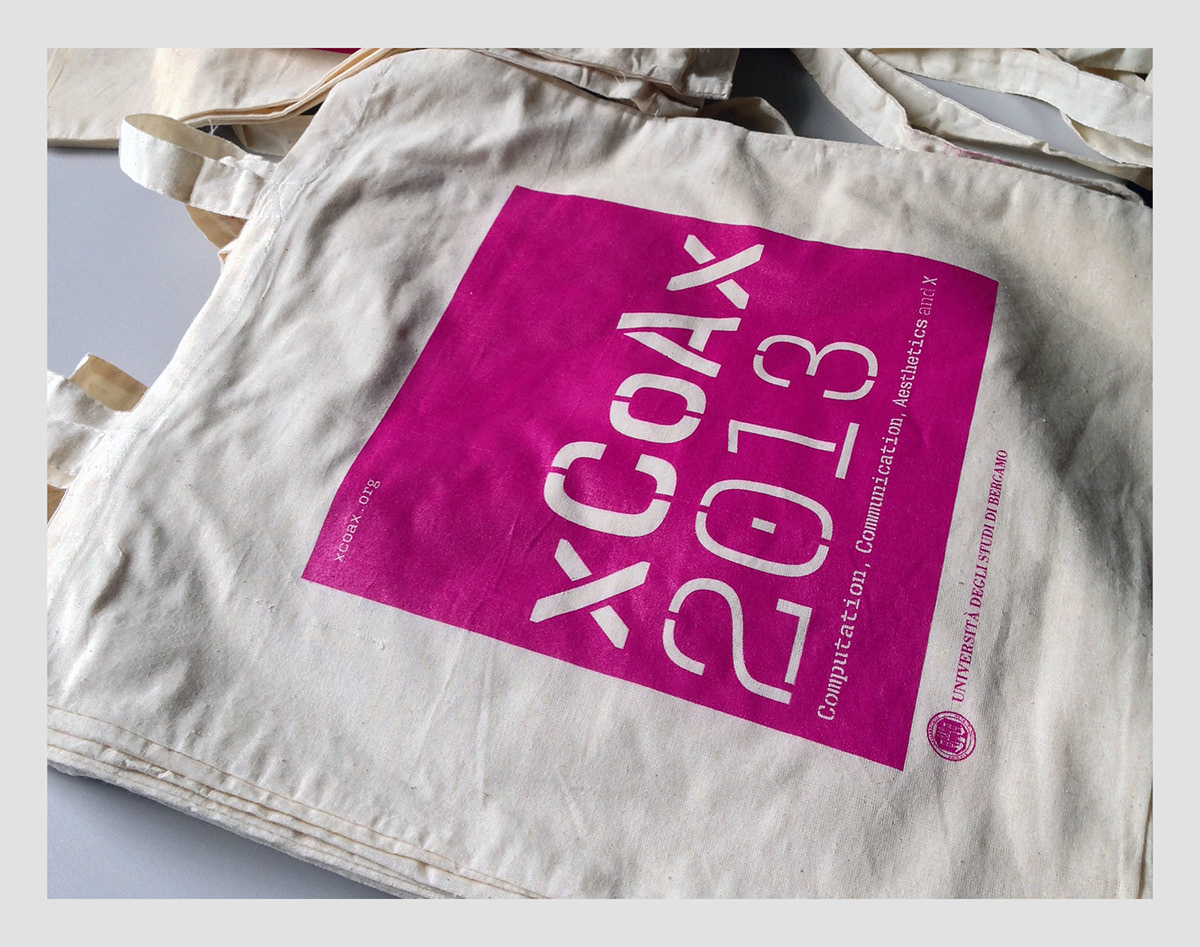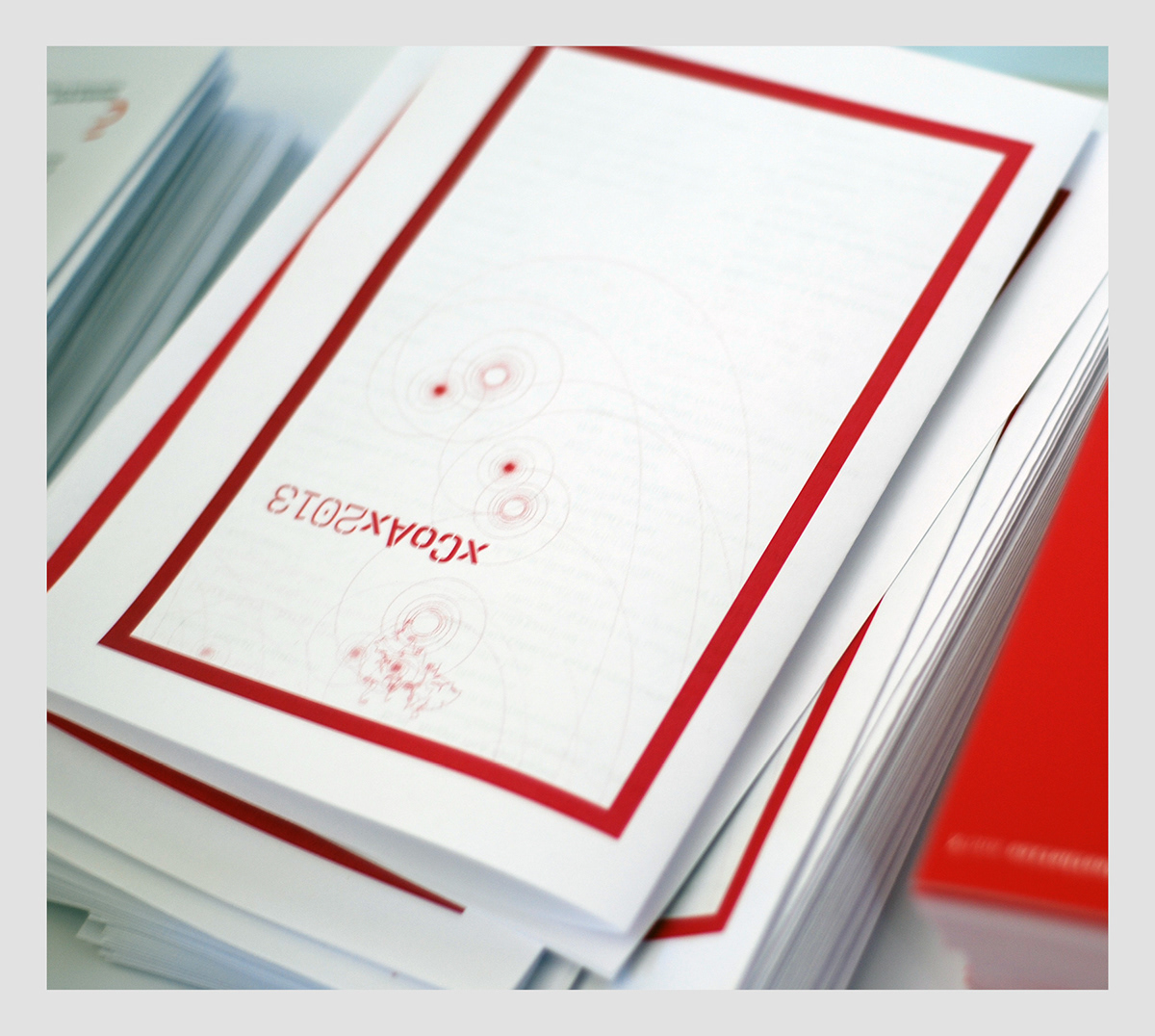The development of computational tools and media has been radically transforming the landscape for the practice of design, the arts and numerous cultural manifestations. Recognizing this, xCoAx is designed as a multi-disciplinary and nomadic enquiry on arts, computers, computation, communication and the elusive x factor that connects them all.
xCoAx is a forum for the exchange of ideas and the discovery of new and profitable synergies. It is an event exploring the frontiers of digital arts with the participation of a diverse confluence of computer scientists, media practitioners and theoreticians, that will focus on the relations between what can and cannot be computed, what can and cannot be communicated, what is beautiful and how humans and computational systems intersect in the development of new directions in aesthetics. (xcoax.org)
Produced during a curricular internship at id:D — Design Lab, in collaboration with Miguel Carvalhais, who designed the stickers, postcards, A3 poster and website, prior to my involvement in the project.
xCoAx is a forum for the exchange of ideas and the discovery of new and profitable synergies. It is an event exploring the frontiers of digital arts with the participation of a diverse confluence of computer scientists, media practitioners and theoreticians, that will focus on the relations between what can and cannot be computed, what can and cannot be communicated, what is beautiful and how humans and computational systems intersect in the development of new directions in aesthetics. (xcoax.org)
Produced during a curricular internship at id:D — Design Lab, in collaboration with Miguel Carvalhais, who designed the stickers, postcards, A3 poster and website, prior to my involvement in the project.
I participated in the development of the remaining applications, namely the conference proceedings, large scale posters for signage and short paper presentations, tote bags, identification cards, conference program and certificate of participation.
March–July 2013.
Organizing committee:
Mario Verdicchio, Jason Reizner, André Rangel, Pedro Tudela & Miguel Carvalhais.
Images:
Lia’s Sum05 (http://www.liaworks.com).
Photography:
Pedro Tudela.
Pedro Tudela.

Projection of the conference's logo during the presentations.
Presentation of 'Robot Quartet', project by Andres Wanner.
Performance by Vilbjørg Broch.
(left, top–bottom)
Detail of a large format poster with information about the performances.
xCoAx2014 stickers, among other communication material.
(right, top–bottom)

Cover, foreword, index of contents and article of the Conference Proceedings.
Conference Proceedings
The conference proceedings are available in digital format, as a single PDF file and as individual articles, at 2013.xcoax.org. It was taken under consideration the possibility that they could be printed, therefore being chosen the A4 format, as it’s a standard printing size.
While designing the layout, beside wanting that all the elements and hierarchies worked well together, it was important to remember that this was a scientific publication, so it shouldn’t distract the reader. However, it didn’t need to look dense and boring.
As the articles are distributed individually as well, they start on an odd page and mention the conference name and date.
As the articles are distributed individually as well, they start on an odd page and mention the conference name and date.

Tote Bags
There were some issues to consider when designing the bags: the maximum printing area was of 170cm2 and because it would be done in screen-print, there could be only two colours with no gradients: black and magenta.
At first it was asked that the logo of the University of Bergamo was isolated on one of the sides, but in the end it was found a way to print all of the information on the same side in one color, giving special relevance to the acronym of the conference.


Id cards for the organizing committee.
Identification Cards
Although having been studied several possible formats and materials, there was the opportunity to produce the ids in precut pet plastic.
It was created a model for the participants, containing the acronym of the conference and name and affiliation of the participant.
For the organization committee to stand out, it was created an inverted version with a magenta background.
The cards were printed on both sides, so that flipping over wouldn’t be a problem.
It was also possible to print on the lanyards, which was pleasing, since they wouldn’t dissociate from the conference once removed from the card. It was chosen a minimalistic approach which encompasses acronym, year and URL: 2013.xCoAx.org.

Display of the large format posters for the short papers and performances (top).
Detail of the poster signalling the entrance (bottom).
Detail of the poster signalling the entrance (bottom).
Posters
The spaces of the conference also had to be identified. Large scale posters were designed for the entrance, help desk and for the performances to be held.
The short papers and demos were also exhibited in the same way. Initially they were to be hung from a metallic structure and mounted on an acrylic board. However, it was later decided this option could be unsafe, so it was decided to mount the posters on mdf boards of 120×220cm.
To signal the rooms it was chosen the A3 format, as once inside the premises it would be fairly easy to identify the different spaces.
Certificate of Participation
It was created a certificate to deliver to the participants by the end of the conference. As this process would be handled by the secretariat services at the University of Bergamo, it was necessary to create an MS Word template that was as user-friendly as possible. The result was a form in which only the name and affiliation fields can be modified. Even the font can’t be changed. This way, it was possible to preserve the designed layout and still enable anyone to fill in the document.

Detail of a large scale poster (top).
The stage where the performances took place and projection of the identity of xCoAx2014 (bottom).




